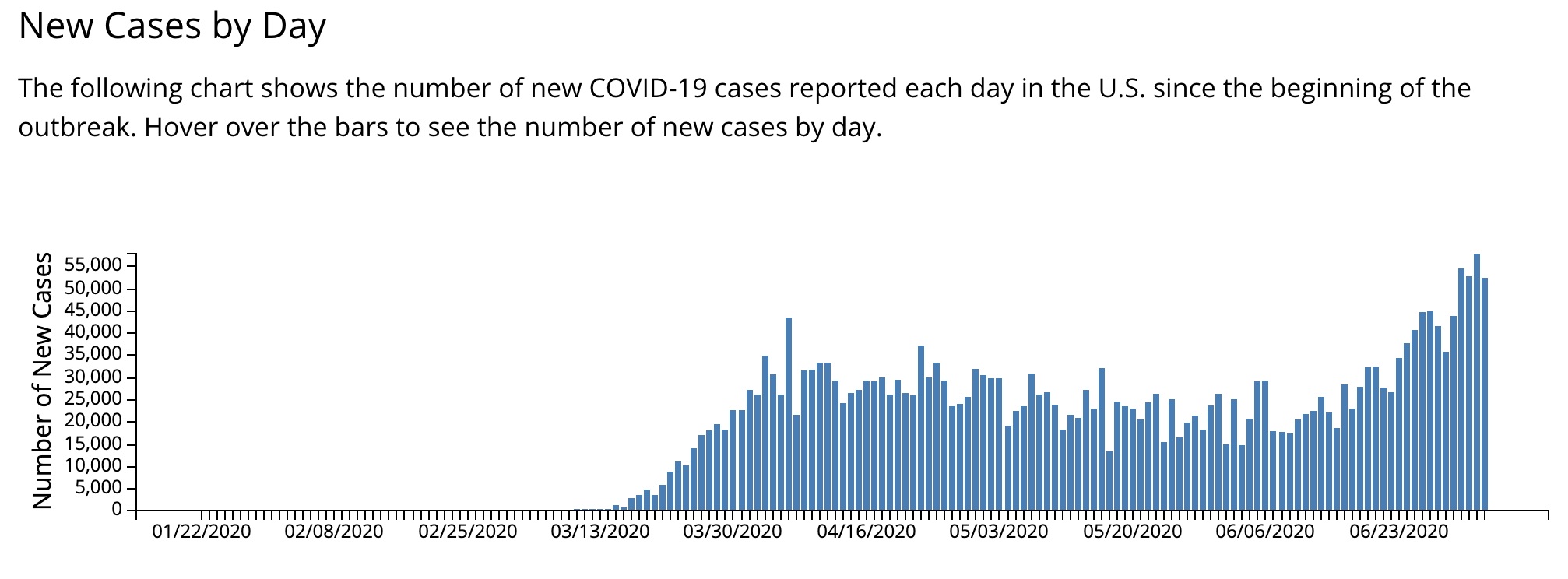America Dances (part 1)

Source: US CDC, July 5, 2020 https://www.cdc.gov/coronavirus/2019-ncov/cases-updates/cases-in-us.html
America “Dances” with Coronavirus
Back in early May I wrote the final post in my Endgame series, talking about Tomas Pueyo’s “hammer and dance” strategy to living with the pandemic. At the time, the US was in the “hammer” phase, with most states under some form of shelter-in-place / lockdown. Today, in early July, Americans are living “the dance.”
To summarize my previous points, the dance is the entire time between lockdown and herd immunity. Instead of letting the virus run wild, the dance is all about using sustainable measures to keep the epidemic at a low simmer rather than a boil. The primary goal is to use non-pharmaceutical interventions (NPIs) to maintain economic activity while protecting the health care system from overload.
How’s the dance going?
The US has fifty different dances in play. More, if you consider that a lot of decision making has been devolved to counties. In general the answer is, not great. Look at the graph at the top of this post. New COVID-19 cases per day in the US have been growing steadily. A new record high has been set on 4 of the last 9 days. Some hospital systems, especially in Arizona and Texas, are bending from the strain of admissions. Given the time lag of weeks between infections and hospitalizations, that strain is going to worsen and spread to more places.
Based on observed data, many parts of the US need to adjust their dance. That may include some government-level reversal of aspects of reopening, but mostly it means people need to change their behavior. In Sacramento County, rising case numbers are being driven by people gathering in private settings. Shutting down the economy wouldn’t fix that.
Does this mean we wasted the lockdown?
No. The purpose was to flatten the curve, and to buy time. We did both of those things. Complete lockdown, and across-the-board shelter in place regulations, were the hammer that set up the conditions for our dance. But our current dance steps are not good enough, and we are definitely squandering some of the gains we made. Americans need to stick with social distancing, mask wearing, and as many other NPIs as we can put up with for an extended time. Prepare for another year.
We have made a lot of progress in the short time since we detected SARS-CoV-2 in the US in February. We now understand that people may be most infectious immediately before they show symptoms—hence the value of wearing a mask to protect others even if you feel healthy. We have learned better medical management of hospitalized COVID patients, and have reduced the mortality rate. We know that over-activation of the immune system contributes to mortality, and that the drugs remdesivir and dexamethasone help some patients. Testing has increased (though it remains inadequate—see my next post).
Maybe the most important thing we accomplished by using “the hammer” is we’ve made millions of individual, private adjustments to the way we conduct business and engage in public in order to minimize disease spread. Plexiglas shields, touchless payments, redesigned office spaces, modified supply chains, behavior modification—all of these NPIs are crucial to our ongoing dance. Some jobs have returned. Some industries have found workarounds. Unfortunately as long as the virus continues to circulate in our communities, some sectors of the economy will be locked out because people cannot gather indoors, in groups, for any prolonged period of time for fear of spreading the virus. (It doesn’t have to be this way during the dance, but America has chosen this path. More on this in my next post.)
This is a crucial moment for us to really get our dance in order. We need to slow down the growth in new cases. Partly that’s to help us right now, and two weeks from now. Even more important, we need to establish good habits for a dance that works because soon we’ll be adding two major stressors that will make our dance much harder. In a few weeks schools will start to reopen and not long after that, flu season will begin.
If we can’t dance now, we’re in big trouble this fall.
NEXT: Part 2: Whose dance is best?
Amy Rogers, MD, PhD, is a Harvard-educated scientist, novelist, journalist, and educator. Learn more about Amy’s science thriller novels, or download a free ebook on the scientific backstory of SARS-CoV-2 and emerging infections, at AmyRogers.com.
Sign up for my email list
Share this:



0 Comments